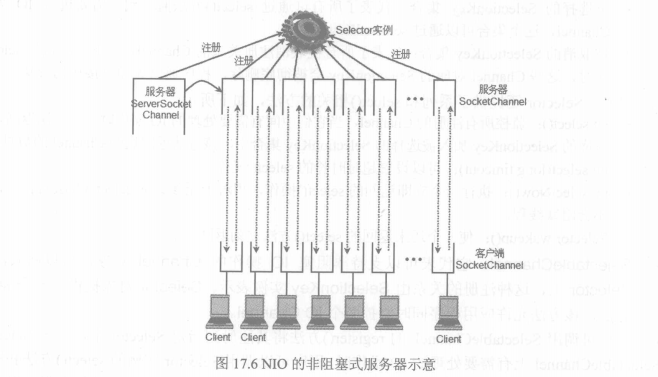转自:https://blog.csdn.net/yanmei_yao/article/details/8586199
除了普通的Socket与ServerSocket实现的阻塞式通信外,java提供了非阻塞式通信的NIO API。先看一下NIO的实现原理。

从图中可以看出,服务器上所有Channel(包括ServerSocketChannel和SocketChannel)都需要向Selector注册,而该Selector则负责监视这些Socket的IO状态,当其中任意一个或者多个Channel具有可用的IO操作时,该Selector的select()方法将会返回大于0的整数,该整数值就表示该Selector上有多少个Channel具有可用的IO操作,并提供了selectedKeys()方法来返回这些Channel对应的SelectionKey集合。正是通过Selector,使得服务器端只需要不断地调用Selector实例的select()方法即可知道当前所有Channel是否有需要处理的IO操作。
看个demo
NClient.java
-
import java.io.IOException;
-
import java.net.InetSocketAddress;
-
import java.nio.ByteBuffer;
-
import java.nio.channels.Channel;
-
import java.nio.channels.SelectionKey;
-
import java.nio.channels.Selector;
-
import java.nio.channels.ServerSocketChannel;
-
import java.nio.channels.SocketChannel;
-
import java.nio.charset.Charset;
-
public class Server {
-
public static void main(String[] args) {
-
int port = 8082;
-
int backlog = 3000;
-
Charset charSet = Charset.forName(“UTF-8″);
-
try {
-
Selector selector = Selector.open();
-
ServerSocketChannel channel = ServerSocketChannel.open();
-
channel.bind(new InetSocketAddress(“localhost”,port), backlog);
-
channel.configureBlocking(false);
-
channel.register(selector, SelectionKey.OP_ACCEPT);
-
while(selector.select()>0){
-
for(SelectionKey sk:selector.selectedKeys()){
-
//移除,TODO
-
selector.selectedKeys().remove(sk);
-
if(sk.isAcceptable()){
-
ServerSocketChannel ssc = (ServerSocketChannel) sk.channel();
-
//SocketChannel sc = channel.accept();
-
SocketChannel sc = ssc.accept();
-
sc.configureBlocking(false);
-
sc.register(selector, SelectionKey.OP_READ);
-
sk.interestOps(SelectionKey.OP_ACCEPT);
-
}
-
if(sk.isReadable()){
-
SocketChannel saChannel = (SocketChannel) sk.channel();
-
ByteBuffer buffer = ByteBuffer.allocate(1024);
-
String content = “”;
-
while(saChannel.read(buffer)>0){
-
buffer.flip();
-
content = content + charSet.decode(buffer);
-
}
-
System.out.println(“读取到的数据为:”+content);
-
sk.interestOps(SelectionKey.OP_READ);
-
if(content!=null&&!”".equals(content)){
-
for(SelectionKey sko:selector.keys()){
-
Channel targetChannel = sko.channel();
-
if(targetChannel instanceof SocketChannel){
-
SocketChannel tc = (SocketChannel) targetChannel;
-
tc.write(charSet.encode(content));
-
}
-
}
-
}
-
}
-
}
-
}
-
} catch (IOException e) {
-
e.printStackTrace();
-
}
-
}
-
}
import java.io.IOException;import java.net.InetSocketAddress;import java.nio.ByteBuffer;import java.nio.channels.SelectionKey;import java.nio.channels.Selector;import java.nio.channels.SocketChannel;import java.nio.charset.Charset;import java.util.Scanner;public class NClient {//定义检测SocketChannel的Selector对象private Selector selector=null;//定义处理编码和解码的字符集private Charset charset=Charset.forName("UTF-8");//客户端SocketChannelprivate SocketChannel sc=null;public void init() throws IOException{selector=Selector.open();InetSocketAddress isa=new InetSocketAddress("127.0.0.1",30000);//调用open静态方法创建连接到指定主机的SocketChannelsc=SocketChannel.open(isa);//设置该sc以非阻塞方式工作sc.configureBlocking(false);//将Socketchannel对象注册到指定Selectorsc.register(selector, SelectionKey.OP_READ);//启动读取服务器端数据的线程new ClientThread().start();//创建键盘输入流Scanner scan=new Scanner(System.in);while(scan.hasNextLine()){//读取键盘输入String line=scan.nextLine();//将键盘输入的内容输出到SocketChannel中sc.write(charset.encode(line));}}//定义读取服务器数据的线程private class ClientThread extends Thread{public void run(){try{while(selector.select()>0){//遍历每个有可用IO操作Channel对应的SelectionKeyfor(SelectionKey sk:selector.selectedKeys()){//删除正在处理的SelectionKeyselector.selectedKeys().remove(sk);//如果该SelectionKey对应的Channel中有可读的数据if(sk.isReadable()){//使用NIO读取channel中的数据SocketChannel sc=(SocketChannel) sk.channel();ByteBuffer buff=ByteBuffer.allocate(1024);String content="";while(sc.read(buff)>0){//sc.read(buff);buff.flip();content+=charset.decode(buff);}//打印输出读取的内容System.out.println("聊天信息"+content);//为下一次读取做准备sk.interestOps(SelectionKey.OP_READ);}}}}catch(IOException ex){ex.printStackTrace();}}}public static void main(String[]args) throws IOException{new NClient().init();}}
NServer.java
-
import java.io.IOException;
-
import java.net.InetSocketAddress;
-
import java.nio.ByteBuffer;
-
import java.nio.channels.SelectionKey;
-
import java.nio.channels.Selector;
-
import java.nio.channels.SocketChannel;
-
import java.nio.charset.Charset;
-
import java.util.Scanner;
-
public class Client {
-
private static Charset charSet = Charset.forName(“UTF-8″);
-
public static void main(String[] args) {
-
int port = 8082;
-
try {
-
Selector selector = Selector.open();
-
SocketChannel socketChannel = SocketChannel.open();
-
socketChannel.connect(new InetSocketAddress(“localhost”, port));
-
socketChannel.configureBlocking(false);
-
socketChannel.register(selector, SelectionKey.OP_READ);
-
Scanner scanner = new Scanner(System.in);
-
new ReadMsg(selector).start();
-
while(scanner.hasNextLine()){
-
String line = scanner.nextLine();
-
socketChannel.write(charSet.encode(line));
-
}
-
} catch (IOException e) {
-
e.printStackTrace();
-
}
-
}
-
}
-
class ReadMsg extends Thread{
-
private static Charset charSet = Charset.forName(“UTF-8″);
-
private Selector selector;
-
public ReadMsg(Selector selector){
-
this.selector = selector;
-
}
-
@Override
-
public void run() {
-
try {
-
while(selector.select()>0){
-
for(SelectionKey sk:selector.selectedKeys()){
-
selector.selectedKeys().remove(sk);
-
if(sk.isConnectable()){
-
SocketChannel channel = (SocketChannel) sk.channel();
-
if(channel.isConnectionPending()){
-
channel.finishConnect();
-
}
-
channel.configureBlocking(false);
-
channel.register(selector, SelectionKey.OP_READ);
-
sk.interestOps(SelectionKey.OP_READ);
-
}
-
if(sk.isReadable()){
-
String content = “”;
-
ByteBuffer buffer = ByteBuffer.allocate(1024);
-
SocketChannel channel = (SocketChannel) sk.channel();
-
while(channel.read(buffer)>0){
-
buffer.flip();
-
content = content+charSet.decode(buffer);
-
}
-
System.out.println(“接收到的信息:”+content);
-
sk.interestOps(SelectionKey.OP_READ);
-
}
-
}
-
}
-
} catch (IOException e) {
-
e.printStackTrace();
-
}
-
}
-
}
import java.io.IOException;import java.net.InetSocketAddress;import java.nio.ByteBuffer;import java.nio.channels.Channel;import java.nio.channels.SelectionKey;import java.nio.channels.Selector;import java.nio.channels.ServerSocketChannel;import java.nio.channels.SocketChannel;import java.nio.charset.Charset;public class NServer {//用于检测所有Channel状态的Selectorprivate Selector selector=null;//定义实现编码、解码的字符集对象private Charset charset=Charset.forName("UTF-8");public void init() throws IOException{selector=Selector.open();//通过open方法来打开一个未绑定的ServerSocketChannel实例ServerSocketChannel server=ServerSocketChannel.open();InetSocketAddress isa=new InetSocketAddress("127.0.0.1",30000);//将该ServerSocketChannel绑定到指定ip地址server.socket().bind(isa);//设置ServerSocket以非阻塞方式工作server.configureBlocking(false);//将server注册到指定Selector对象server.register(selector, SelectionKey.OP_ACCEPT);while(selector.select()>0){//依次处理selector上的每个已选择的SelectionKeyfor(SelectionKey sk:selector.selectedKeys()){//从selector上的已选择Key集中删除正在处理的SelectionKeyselector.selectedKeys().remove(sk);//如果sk对应的通信包含客户端的连接请求if(sk.isAcceptable()){//调用accept方法接受连接,产生服务器端对应的SocketChannelSocketChannel sc=server.accept();//设置采用非阻塞模式sc.configureBlocking(false);sc.register(selector, SelectionKey.OP_READ);//将sk对应的Channel设置成准备接受其他请求sk.interestOps(SelectionKey.OP_ACCEPT);}//如果sk对应的通道有数据需要读取if(sk.isReadable()){//获取该SelectionKey对应的Channel,该Channel中有可读的数据SocketChannel sc=(SocketChannel) sk.channel();//定义准备之星读取数据的ByteBufferByteBuffer buff=ByteBuffer.allocate(1024);String content="";//开始读取数据try{while(sc.read(buff)>0){buff.flip();content+=charset.decode(buff);}//打印从该sk对应的Channel里读到的数据System.out.println("=========="+content);//将sk对应的Channel设置成准备下一次读取sk.interestOps(SelectionKey.OP_READ);//如果捕捉到该sk对应的channel出现异常,即表明该channel对应的client出现了//异常,所以从selector中取消sk的注册}catch(IOException e){//从Selector中删除指定的SelectionKeysk.cancel();if(sk.channel()!=null){sk.channel().close();}}//如果content的长度大于0,即聊天信息不为空if(content.length()>0){//遍历该selector里注册的所有SelectKeyfor(SelectionKey key:selector.keys()){//选取该key对应的ChannelChannel targetChannel=key.channel();//如果该channel是SocketChannel对象if(targetChannel instanceof SocketChannel){//将独到的内容写入该Channel中SocketChannel dest=(SocketChannel) targetChannel;dest.write(charset.encode(content));}}}}}}}public static void main(String[]args) throws IOException{new NServer().init();}}
通过java提供的NIO实现非阻塞Socket通信,大大提高了网络服务器的性能。